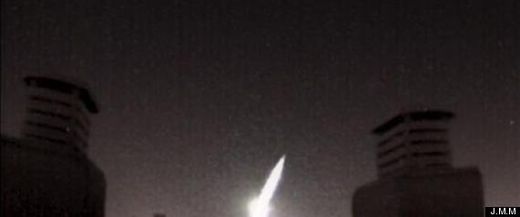
© J. M.M.Fireball over Madrid, July 14, 2012
If you live in the center of the peninsula and last night was awakened by a loud sound and saw how the sky suddenly lit up, it wasn't a dream. About 2:10 in the morning and about 30 or 40 miles above Earth, stellar fragments disintegrated in the atmosphere somewhere between Toledo and Madrid.
"Everything points to a fragment of a comet,", Jose Maria Madiedo,
professor of the Faculty of Experimental Sciences of Huelva told
The Huffington Post.
"It was like a flash in the sky like a beacon light that came from heaven," said Rafael Rojas, a journalist who saw while working at his flat in Madrid and immediately tweeted what happened in search of an explanation, a little scared. His reaction is not surprising: "It was almost as bright as the sun, for a second day was done. Impressive," says researcher Huelva. They are still investigating the phenomenon. This type of very bright meteors are called fireballs.
The flash, the expert explained, had been so strong that it had even been noted in Sierra Nevada, 300 or 400 miles. Witnesses have spoken on social networks (where the phenomenon has been commented on under the hashtag
# meteoritomadrid ) also [produced] a loud noise. "It probably been accompanied by sound, depends on where the observer has been located," said Madiedo. "In these cases you hear an explosion similar to that heard when an airplane breaks the sound barrier."
MORE THAN A SHOOTING STARIt is a rare phenomenon, although it is strange that matches its fall with the existence of inhabited areas. A similar event occurred
near Bejar, Salamanca, in July 2008 . At that time the brightness was observed from the Pyrenees.
For those looking for space debris in your garden, a warning: it is unlikely that any fragments [will be found], according to Madiedo. "If you have treated the breakup of a comet in contact with the atmosphere, this piece of comet is completely destroyed."
The expert compared to the usual shooting stars, but with a magnitude far greater: "A shooting star is a material the size of a grain of sand that is destroyed on contact with the atmosphere with a very high speed, about 72 kilometers per second. That means that its temperature is raised to 5,000 degrees as the sun's surface, or even more. When we speak of a larger fragment is the same phenomenon but more exaggerated and therefore can be seen a very bright explosion, "he says.
Experts from various universities and research centers now analyze all data. "We know at what point he began to shine, what location, chemical composition, size ... practically everything. And that is thanks to the sensors located throughout the Peninsula, which allows us to collect information when there is a significant event as this.", adds Madiedo

Reader Comments
to our Newsletter